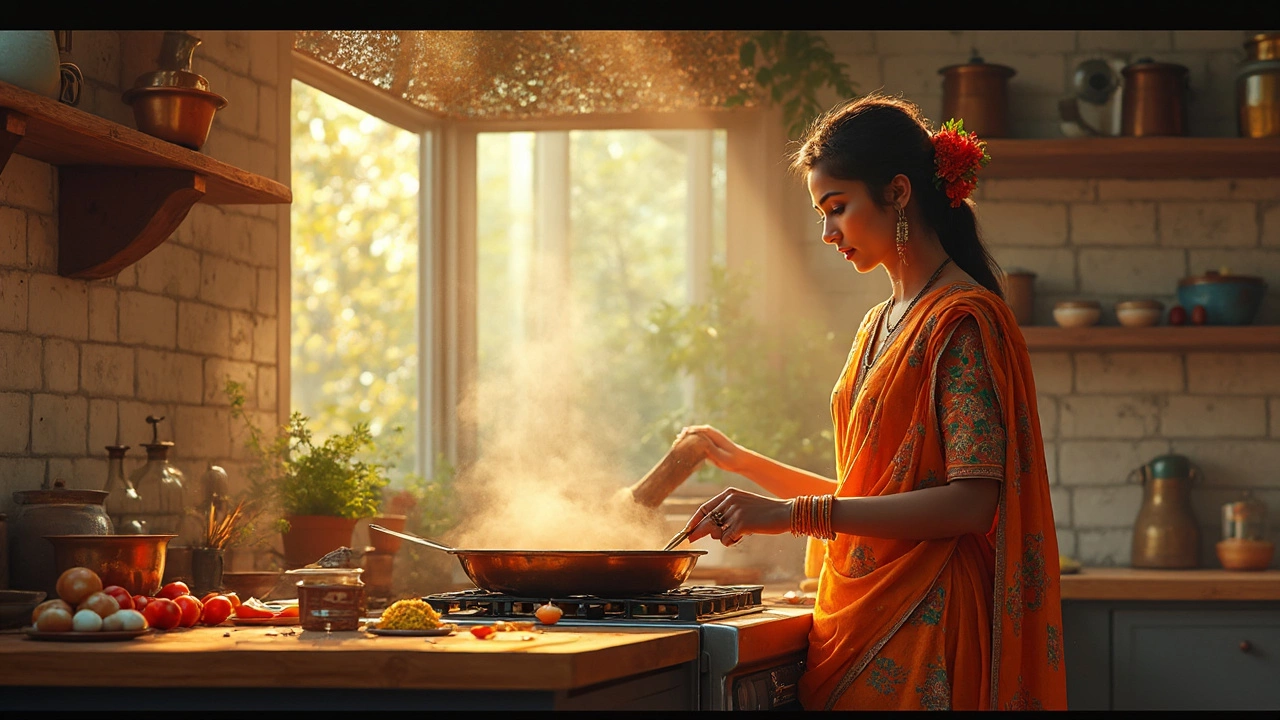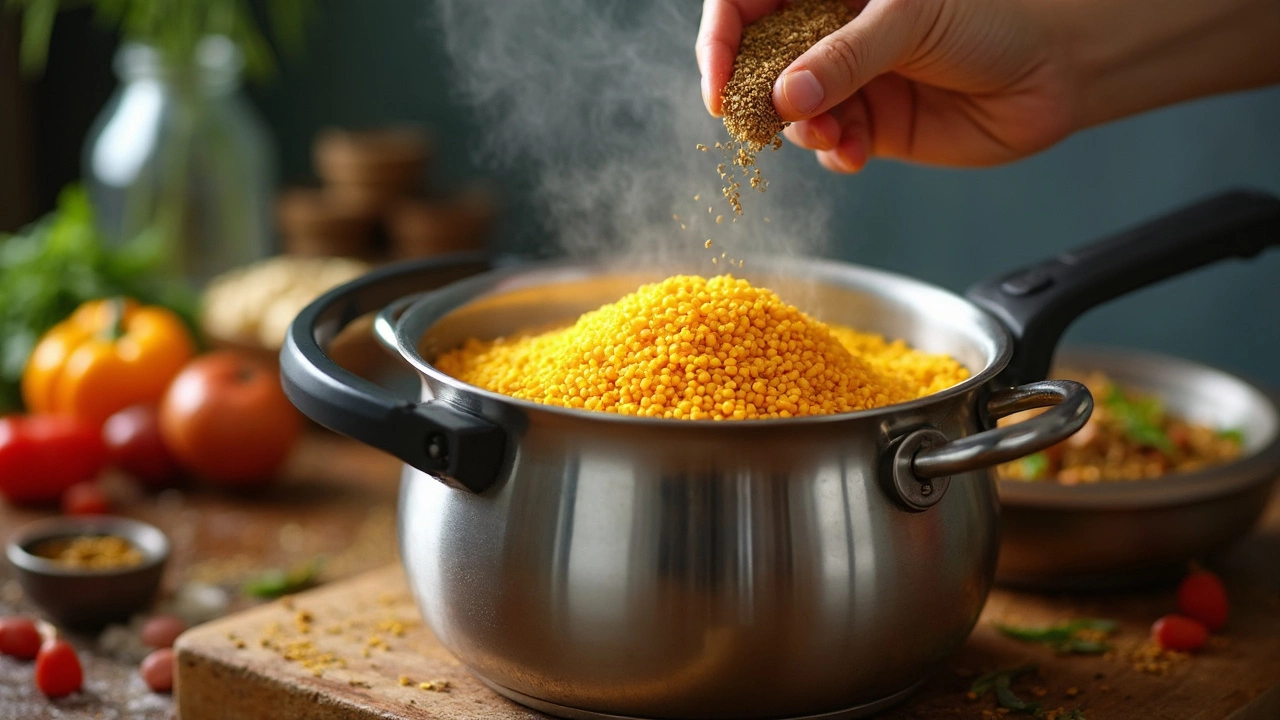Which Dal Does Not Need Soaking? Dal Recipe Simple Guide

Waiting for dal to soak can totally kill your dinner vibe, right? Good news—some dals don’t need soaking at all. If you’ve got hunger pangs and zero patience, the secret weapon is in your pantry: moong dal, especially the split yellow kind. This one’s so soft, it cooks right through without a soak, even in a regular pot.
Urad dal (the split, skinless version) sometimes gets away without soaking, but it's trickier—can take a bit longer and might not turn out as creamy unless you’ve got a pressure cooker. Chana dal and whole masoor dal? Don’t even try skipping the soak unless you’re cool with crunchy lentils ruining your meal.
So, next time you’re eyeing that dal packet, remember: split yellow moong dal wins when you’re chasing speed. Washing them a few times to get rid of extra starch is enough. Want them even softer? Add a pinch of turmeric and a glug of oil while cooking. That’s how your dal turns silky and bright in half the time.
- Why Soak Dal in the First Place?
- Dals You Can Skip Soaking
- How to Cook Dal Without Soaking
- Quick Dal Recipe: Ready in 20 Minutes
Why Soak Dal in the First Place?
Ever wondered why grandma insists on soaking dal before cooking? The real reason isn’t just about tradition. Soaking dal helps it cook faster and gives it a creamier texture. Harder dals, like chana dal or whole urad dal, are tough little guys—they take forever to soften unless you give them a head start in water.
The science is simple. When you soak dal, it absorbs water. That means less time boiling in the pot, and you save on gas or electric bills. Less cooking also keeps more nutrients in the lentils, so you’re not boiling all the good stuff away. Plus, soaking gets rid of some of the stuff that can make you feel bloated, making your dal easier on the stomach.
Check out this quick comparison—average soaking and cooking times for the most common dals:
| Dal Type | Soaking Needed? | Average Cook Time (without soaking) |
|---|---|---|
| Moong Dal (split, skinless) | No | 15-20 min |
| Chana Dal | Yes | 40-50 min |
| Whole Masoor Dal | Yes | 35-40 min |
| Toor Dal | Recommended | 35-45 min |
If you forget to soak your dal and need it fast, some split lentils like yellow moong can step up. But for the hardier varieties, no amount of fast boiling will save you from tough, half-cooked bites.
So, while soaking isn’t always a must—especially for dal without soaking like moong dal—it totally pays off for the tougher types. If you’re in a rush, stick with the easy ones and save the tough dals for when you’ve got more time.
Dals You Can Skip Soaking
If you want a fast meal and don’t want to mess with soaking, knowing which dal to pick is half the battle. The real standout is moong dal, especially the split yellow kind. This dal is tender, cooks super fast, and pulls off the creamy, melt-in-your-mouth vibe even without soaking. Both in a pressure cooker and on the stovetop, it breaks down easy and absorbs flavors quickly. That’s why tons of quick dal recipes lean on moong dal.
Another option is the split, skinless version of urad dal. It cooks without soaking, but honestly, it does best in a pressure cooker—otherwise, there's a chance it turns out a little chewy or pasty. It’s great for dals like dhuli urad and base for quick dal tadka. Still, it's not quite as forgiving as moong dal if you’re using a plain saucepan.
Whole masoor dal (the reddish-brown lentil) sometimes gets the nod in quick recipes, but it's a gamble. Without soaking, you need to be patient, and even then, the texture might be a bit more toothsome than most people want. It’s doable in an emergency, but not ideal if you’re after soft, soupy dal without soaking.
- Moong Dal (yellow, split): Best choice for skipping soaking, cooks in 15–20 minutes.
- Urad Dal (white, split, skinless): Can skip soaking; better in a pressure cooker.
- Masoor Dal (red, split): Thin and quick to cook; soaking isn’t needed but helps improve texture.
By contrast, chana dal and whole urad dal absolutely need soaking or you’ll be waiting forever for them to get soft. These varieties are denser and take much more time to cook through, even under pressure.
| Dal Type | Soaking Needed? | Average Cook Time |
|---|---|---|
| Moong Dal (yellow, split) | No | 15–20 min |
| Urad Dal (white, split) | No (Pressure Cooker Recommended) | 15–25 min |
| Masoor Dal (red, split) | No | 18–25 min |
| Chana Dal | Yes | 35–45 min |
When you need a speedy meal, grab moong dal and skip right to cooking. Save the denser dals for days when you have extra time or want to meal prep ahead.

How to Cook Dal Without Soaking
So, you want steaming hot dal without soaking and you want it fast. Totally possible if you pick the right type—split yellow moong dal works best. Here’s how to get it done, no soaking, no excuses.
First, rinse your dal really well—like, until the water is mostly clear. This washes away dirt and some of that extra starch that can make your dal slimy.
- Measure out the amount you want (1 cup feeds 2 hungry people easily).
- Rinse until water runs clear. No need for a soak.
- Drop dal into your pot or pressure cooker with triple the water (so, 1 cup dal means 3 cups water).
- Add a pinch of turmeric, some salt, and a few drops of oil. This stops the dal from getting foamy and gives a nice color. Turmeric is also thought to help with digestion—win-win.
- Bring to a boil, then drop to a simmer. If you’ve got a pressure cooker, close the lid and cook for about 2 whistles (roughly 6-8 minutes).
- If you’re using a regular pot, cover and simmer gently for 15-20 minutes. Stir now and then so nothing gets stuck at the bottom.
- Once soft, mash with the back of a spoon for creamy dal, or leave some texture if that’s more your style.
Pro Tip: For super quick dal, nothing beats a pressure cooker. If you’re doing this on the stovetop, resist the urge to crank the heat. Low and slow gives better, creamier moong dal.
Here’s a quick look at average cooking times—handy if you’re trying to avoid gritty bites:
| Dal Type | Soaking Needed? | Stovetop (min) | Pressure Cooker (min) |
|---|---|---|---|
| Split Yellow Moong Dal | No | 15-20 | 6-8 |
| Split Skinless Urad Dal | Optional | 25-30 | 10-12 |
| Chana Dal | Yes | 40+ | 20-25 |
If you’re aiming for quick dal recipes, stick with moong dal and keep the stove simple. No soak, no fuss, ready before your rice even finishes cooking.
Quick Dal Recipe: Ready in 20 Minutes
When you need dinner on the table fast, split yellow moong dal is your go-to hero. This dal cooks in under 20 minutes from scratch—no soaking, no drama. Here’s how to pull off a super simple, tasty dal recipe simple that will save your weeknight.
- Wash 1 cup split yellow moong dal 3-4 times with cold water until the water runs mostly clear.
- Boil dal with 3 cups water, ¼ teaspoon turmeric powder, and a pinch of salt. Use either a regular saucepan or a pressure cooker. On the stove, simmer for about 15-17 minutes; with a pressure cooker, 2 whistles do the trick.
- While dal cooks, heat 1 tablespoon oil (or ghee) in a pan. Toss in ½ teaspoon cumin seeds, 1 chopped green chili, and 1 chopped tomato. Sauté for 2-3 minutes.
- Add a pinch of red chili powder, then pour this tadka straight into your cooked dal. Mix well, and let it simmer together for a couple of minutes to blend flavors.
- If needed, add hot water for your preferred consistency. Taste for salt and spice—adjust as you like.
- Serve with rice, roti, or just eat it straight out of the bowl with a squeeze of lemon juice and some fresh coriander on top.
Need a tip? If you’re strict on timing, stick with moong dal recipe—no other dal cooks this fast without soaking. And if you’re feeding more, just double the recipe. You won’t need to change the cooking time by much.
| Dal Type | Soaking Needed? | Average Cook Time |
|---|---|---|
| Split Yellow Moong Dal | No | 15-20 min |
| Chana Dal | Yes | 30-40 min |
| Toor Dal | Recommended | 25-30 min |
| Whole Masoor Dal | Yes | 40-45 min |
For days when you crave comfort and speed, this dal without soaking will never fail you.